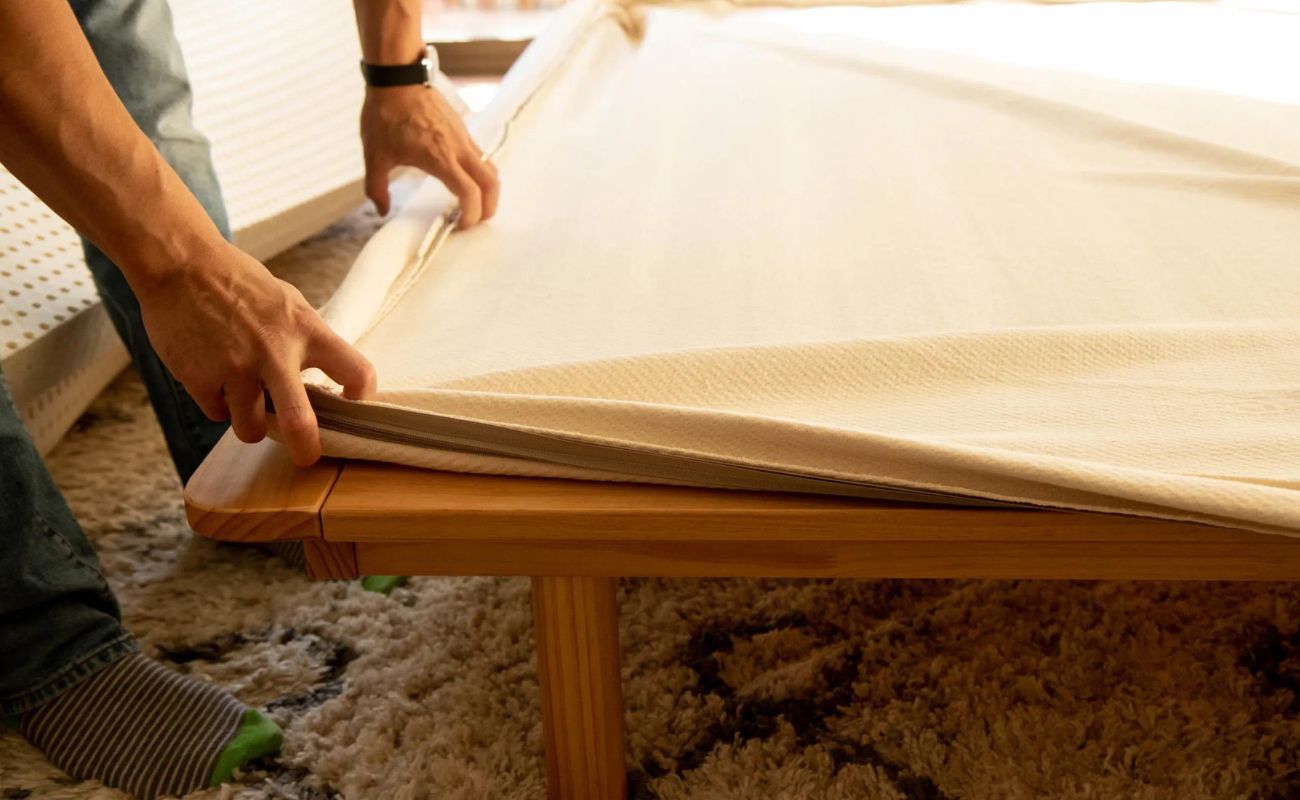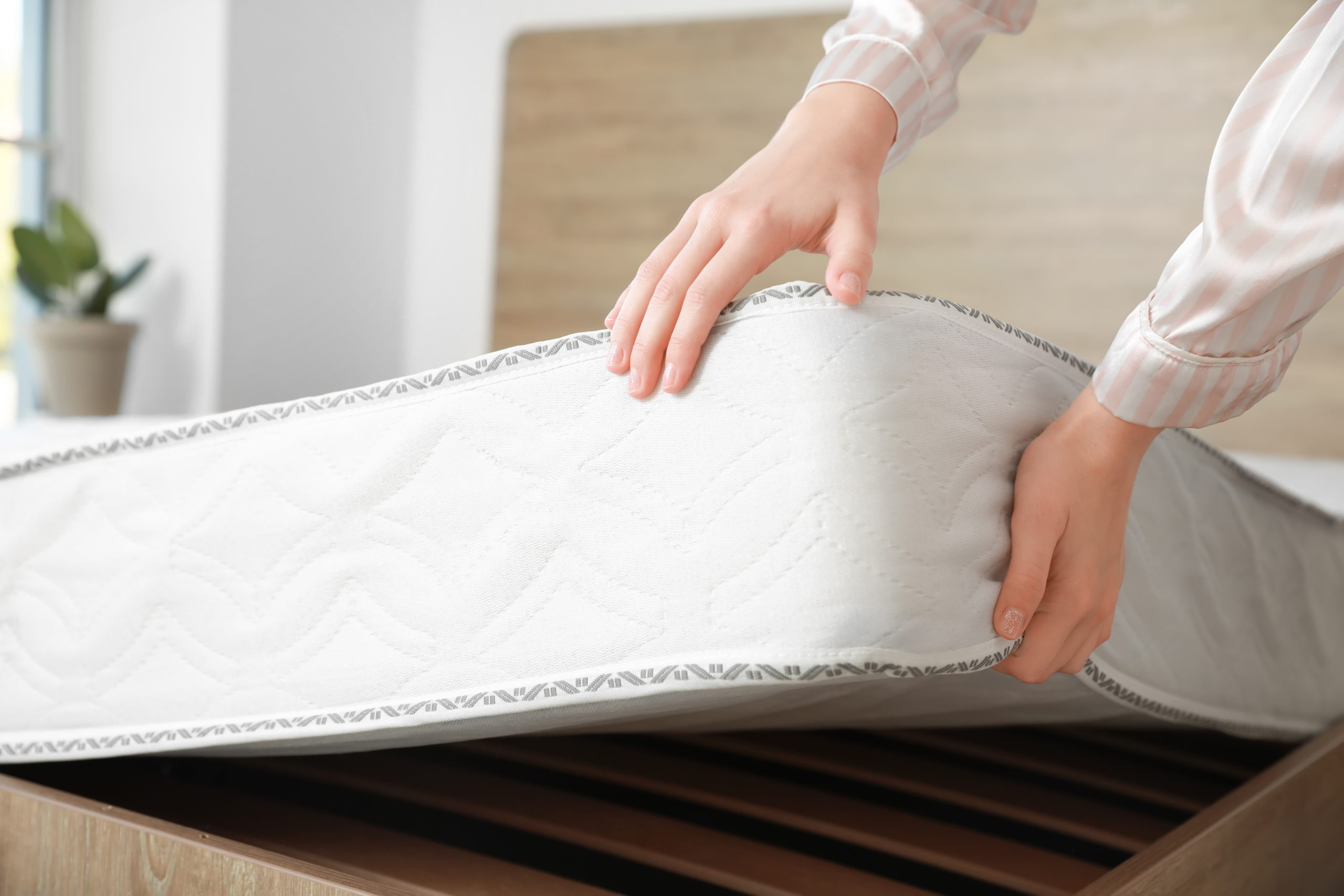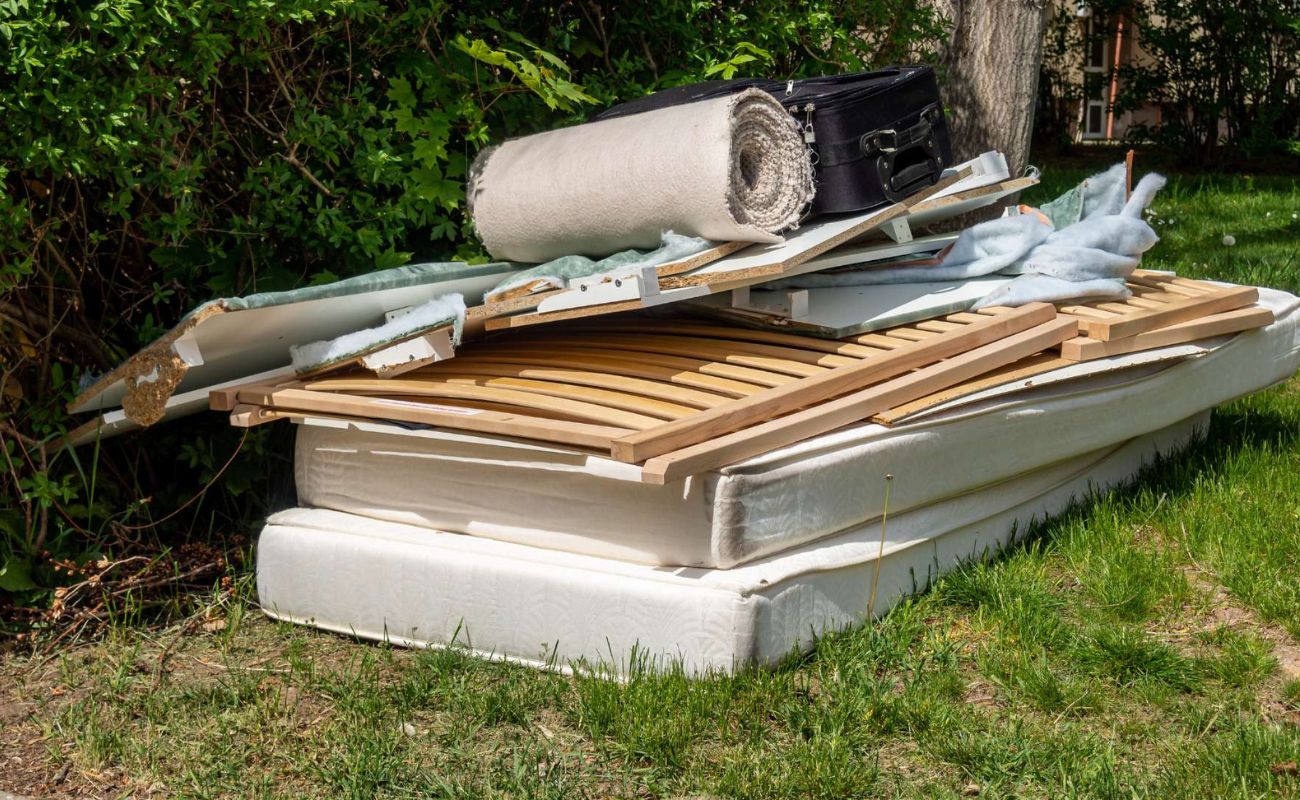Home>Furniture>Bedroom Furniture>How To Build A Mattress


Bedroom Furniture
How To Build A Mattress
Modified: August 23, 2024
Learn how to build a comfortable mattress for your bedroom with our expert tips and advice. Explore different types of bedroom furniture and create the perfect sleeping environment.
(Many of the links in this article redirect to a specific reviewed product. Your purchase of these products through affiliate links helps to generate commission for Storables.com, at no extra cost. Learn more)
Introduction
When it comes to creating the perfect sleeping environment, a crucial element is having the right mattress. A well-built mattress ensures comfort, support, and a peaceful night’s sleep. While there are plenty of options available in the market, building your own mattress can give you complete control over the materials and customization, allowing you to create a personalized sleep experience that suits your specific needs.
In this article, we will guide you through the process of building your own mattress, step by step. From choosing the right materials to assembling and testing the final product, we will provide you with all the information you need to create a comfortable and supportive sleeping surface. So, roll up your sleeves and let’s get started on this exciting DIY project!

Key Takeaways:
- Building a custom mattress allows you to choose the perfect materials for personalized comfort, support, and durability, ensuring a restful and rejuvenating sleep experience tailored to your unique needs.
- Testing and adjusting your DIY mattress enables you to fine-tune its firmness, support, and motion isolation, ensuring a customized sleep surface that meets your specific comfort requirements for a blissful night’s sleep.
Read more: How To Build Twin Memory Foam Mattress
Choosing the Right Materials
The first step in building a mattress is selecting the materials that will be used. The two main components of a mattress are the support layer and the comfort layer.
For the support layer, a common material used is high-density foam. This type of foam provides a stable base and helps distribute body weight evenly. It also offers durability and longevity to the mattress.
When it comes to the comfort layer, there are various options to consider. Memory foam, known for its ability to contour to the body’s shape, provides excellent pressure relief and support. Latex foam, on the other hand, offers a more responsive and natural feel. Another alternative is a combination of different comfort materials to achieve a balance of support and cushioning.
Additionally, you will need a mattress cover that helps protect the layers, adds a finishing touch, and enhances the overall aesthetics of the mattress. Choose a breathable and hypoallergenic fabric that suits your preferences.
Before purchasing the materials, measure the dimensions of the bed frame or the area where the mattress will be placed. This will ensure that you get the right sizes of foam and fabric to construct the mattress correctly.
Once you have gathered all the necessary materials, it’s time to move on to the next step: measuring and cutting the foam.
Key Takeaways:
- Building a custom mattress allows you to choose the perfect materials for personalized comfort, support, and durability, ensuring a restful and rejuvenating sleep experience tailored to your unique needs.
- Testing and adjusting your DIY mattress enables you to fine-tune its firmness, support, and motion isolation, ensuring a customized sleep surface that meets your specific comfort requirements for a blissful night’s sleep.
Read more: How To Build Twin Memory Foam Mattress
Choosing the Right Materials
When it comes to building a high-quality mattress, selecting the right materials is of utmost importance. The materials you choose will directly affect the comfort, durability, and overall performance of your mattress. Here are some key factors to consider when choosing materials for your mattress:
Support Layer:
The support layer is the foundation of the mattress and provides the necessary support for your body. One common material used for the support layer is high-density foam. High-density foam offers excellent durability and stability, ensuring that the mattress maintains its shape and supports your body weight evenly. It helps prevent sagging and provides a firm surface to sleep on. Another option for the support layer is pocketed coils, which offer excellent motion isolation and contouring support.
Comfort Layer:
The comfort layer is responsible for providing cushioning and pressure relief. Memory foam is a popular choice for the comfort layer as it conforms to the body’s contours, relieving pressure points and enhancing comfort. It also has excellent motion isolation properties, making it ideal for couples. Latex foam is another option for the comfort layer, known for its natural elasticity and responsiveness. It provides a more bouncy and buoyant feel compared to memory foam. Hybrid mattresses combine different materials such as memory foam, latex, and micro coils to provide a balanced feel of contouring and responsiveness.
Read more: How To Fold A Mattress
Cover Material:
The mattress cover not only adds a finishing touch to the mattress but also protects the underlying layers. Look for a cover made from breathable and hypoallergenic materials. Natural fibers like cotton or bamboo are great choices as they allow airflow and keep you cool throughout the night. Additionally, consider a cover with a zippered design for easy removal and cleaning.
Firmness Level:
The choice of materials can also impact the firmness level of your mattress. Softer materials like memory foam tend to offer a plush and contouring feel, while firmer materials like high-density foam provide a firmer and more supportive surface. Consider your personal preferences and any specific sleeping needs you may have, such as back pain or mobility issues, when selecting the materials for your mattress.
Budget:
Lastly, take into account your budget when choosing materials for your mattress. While high-quality materials may come with a higher price tag, investing in durable and supportive materials can ensure your mattress lasts for years. Compare prices and consider the long-term benefits and durability of the materials before making a decision.
By considering these factors and carefully selecting the materials for your mattress, you can create a sleep surface that meets your specific comfort and support needs. Remember to take measurements and ensure you have the correct sizes of materials to construct your mattress accurately.
Now that you have chosen the right materials, it’s time to move on to the next step: measuring and cutting the foam.
Measuring and Cutting the Foam
Now that you have chosen the materials for your mattress, it’s time to move on to the next step: measuring and cutting the foam. This step is crucial to ensure that the foam layers fit perfectly within the mattress frame and provide the desired level of comfort and support. Here’s a step-by-step guide on how to measure and cut the foam:
Read more: How To Dry A Mattress
1. Measure the Mattress Frame:
Start by measuring the dimensions of your mattress frame or the area where the mattress will be placed. Measure the length, width, and height of the frame accurately using a measuring tape. Make sure to account for any additional padding or cushioning that you want to include in your mattress.
2. Determine Layer Thickness:
Decide on the thickness of each foam layer based on your comfort preferences. Typically, mattresses consist of two or three foam layers. The top comfort layer is usually thicker for added cushioning, while the lower support layer provides a sturdy base. Consider the overall height of the mattress as well when determining the thickness of each layer.
3. Cut the Foam Layers:
Using the measurements obtained in the previous steps, mark the dimensions on the foam material using a marker or a pen. Use a straight edge or a ruler to ensure clean and precise lines. Carefully cut the foam along the marked lines using a utility knife or an electric foam cutter. Take your time and make smooth, even cuts to achieve the desired shape and size.
4. Check the Fit:
After cutting each foam layer, place them inside the mattress frame to check the fit. Ensure that the foam layers align properly and fit snugly within the frame. Trim any excess foam if needed to achieve a perfect fit. Remember, a well-fitted foam layer is essential for providing optimal support and comfort in your mattress.
Read more: How To Buy Mattress
5. Consider Zoning or Contouring:
If you prefer a mattress with different zones or contours to cater to specific areas of your body, you can incorporate this during the cutting process. For example, you might want to cut the foam layers in a way that provides extra support for your shoulders or hips. This customization can enhance your overall sleep experience and alleviate pressure points.
By following these steps and taking precise measurements, you can ensure that the foam layers for your mattress are accurately cut and fit perfectly within the frame. Once you have all the foam layers ready, it’s time to move on to the next step: constructing the support layer.
Constructing the Support Layer
After measuring and cutting the foam layers for your mattress, it’s time to move on to the next step: constructing the support layer. The support layer forms the base of the mattress and provides stability and structure. Follow these steps to create a solid support layer:
1. Prepare the Foam Layer:
Take the bottom foam layer that you cut and place it evenly on the mattress frame or foundation. Make sure that it covers the entire area without any gaps. Smooth out any wrinkles or creases in the foam layer to ensure a flat surface.
2. Apply Adhesive (Optional):
If desired, you can use a foam adhesive to bond the foam layer to the mattress frame. This will provide additional stability and prevent shifting of the foam layer over time. Apply the adhesive according to the manufacturer’s instructions, ensuring even coverage across the entire surface of the foam layer.
Read more: How To Elevate A Mattress
3. Add Supportive Inserts (Optional):
For added support and durability, you can consider using supportive inserts in the support layer. These can be in the form of wooden slats or metal grids that are placed on top of the foam layer. The inserts should be evenly spaced to provide uniform support across the mattress surface. Secure them to the mattress frame using screws or other appropriate fasteners.
4. Check Alignment and Stability:
Ensure that the foam layer is aligned properly within the mattress frame and sits evenly. Press down on different areas of the mattress to check for any instability or sagging. Make any adjustments if necessary to achieve a firm and stable support layer.
5. Repeat for Multiple Layers (If Applicable):
If your mattress design includes multiple foam layers, repeat the above steps for each layer, stacking them one on top of the other. Ensure proper alignment and stability between each layer.
By following these steps, you can construct a sturdy and supportive base for your mattress. The support layer is essential for maintaining the shape and integrity of the mattress, providing a solid foundation for the comfort layers that will be added later on. Once the support layer is complete, it’s time to move on to the next step: building the comfort layer.
Building the Comfort Layer
Now that the support layer of your mattress is constructed, it’s time to move on to the next step: building the comfort layer. The comfort layer is responsible for providing cushioning and pressure relief, ensuring a comfortable and restful sleep. Follow these steps to create a plush and supportive comfort layer:
Read more: How To Dismantle A Mattress
1. Layer Placement:
Take the foam layers you have cut for the comfort layer and place them on top of the support layer. Start with the thickest and firmest foam layer as the bottom layer, followed by progressively softer layers on top. This will create a graduated level of comfort and support.
2. Align the Layers:
Ensure that each foam layer is aligned properly and sits evenly on top of the previous one. Smooth out any wrinkles or creases in the foam layers to achieve a seamless surface. The layers should fit snugly within the mattress frame and cover the entire area without any gaps.
3. Consider Zoning or Contouring:
If you prefer a mattress with different zones or contours to cater to specific areas of your body, now is the time to incorporate them. You can cut or shape the foam layers accordingly to provide additional support or softness to targeted areas such as the shoulders, hips, or lower back. This customization can enhance your overall sleep experience and alleviate pressure points.
4. Secure the Layers (Optional):
To prevent the foam layers from shifting over time, you may choose to secure them together with a foam adhesive. Apply the adhesive according to the manufacturer’s instructions, ensuring even coverage across the entire surface of each layer. Alternatively, you can use a mattress cover that encases the foam layers tightly, keeping them in place.
Read more: How To Hide A Mattress
5. Test the Comfort:
Once the comfort layer is assembled, lie down on the mattress and test its comfort level. Pay attention to the support provided by the foam layers and how they contour to your body. It’s important to achieve a balance between plushness and support to ensure a comfortable and restful sleep.
By following these steps, you can create a customized comfort layer that provides the desired level of cushioning and pressure relief. Building your own comfort layer allows you to tailor the mattress to your specific preferences and sleep needs, ensuring a personalized sleep experience.
Once the comfort layer is complete, it’s time to move on to the next step: assembling the mattress.
Assembling the Mattress
With the support layer and comfort layer in place, it’s time to move on to the next step: assembling the mattress. This step involves bringing all the components together to create a unified and functional mattress. Follow these steps to assemble your mattress:
1. Place the Comfort Layer:
Start by carefully placing the comfort layer on top of the support layer. Ensure that the foam layers are aligned properly and fit snugly within the mattress frame. Smooth out any wrinkles or creases in the foam layers to achieve a flat and even surface.
2. Secure the Layers:
If you haven’t already done so, consider securing the layers together to prevent shifting over time. You can use a foam adhesive or opt for a mattress cover that encases the foam layers tightly. If using a mattress cover, ensure that it fits properly and provides adequate protection and support.
Read more: How To Sterilize A Mattress
3. Check for Uniformity:
After placing and securing the layers, inspect the mattress for any uneven areas or lumps. Gently press down on different areas of the mattress to ensure that it offers consistent support and cushioning throughout. Make any necessary adjustments to achieve a level and comfortable sleep surface.
4. Allow for Proper Ventilation:
Ensure that the mattress has proper ventilation to prevent the buildup of heat and moisture. Use a breathable mattress cover and allow air to circulate around the mattress. This helps maintain a cool and hygienic sleep environment.
5. Test the Mattress:
After assembling the mattress, take some time to lie down and test its comfort and support. Pay attention to how the mattress contours to your body and whether it provides the desired level of firmness and plushness. It’s important to ensure that the mattress meets your sleep preferences and provides a restful and comfortable experience.
By following these steps, you can successfully assemble your own mattress, tailored to your specific needs and preferences. Enjoy the satisfaction of creating a personalized sleep surface that provides the utmost comfort and support.
Now that the mattress is assembled, it’s time for the final step: adding the mattress cover.
Adding the Cover
With the mattress layers assembled, the next step is to add the mattress cover. The cover not only adds a finishing touch to the mattress but also protects the foam layers and enhances the overall aesthetics. Follow these steps to add the cover to your DIY mattress:
Read more: How To Choose A Mattress
1. Choose the Right Cover:
Select a mattress cover that suits your preferences in terms of material, design, and functionality. Consider a cover made from breathable and hypoallergenic fabric, such as cotton or bamboo, for optimal comfort and hygiene. Choose a cover with a zippered design, if possible, as this makes it easier to remove and clean.
2. Prepare the Cover:
Lay the mattress cover flat on the ground or a clean surface. Unzip the cover, if applicable, to prepare it for the next step.
3. Insert the Mattress Layers:
Carefully lift the assembled mattress layers and slide them into the cover. Ensure that the foam layers fit snugly and evenly within the cover. Adjust the layers if necessary to achieve a proper fit.
4. Zip or Secure the Cover:
If your mattress cover has a zipper, zip it up to encase the layers completely. Make sure the zipper is securely fastened to keep the layers in place. If your cover doesn’t have a zipper, use the provided fasteners or closures to secure the cover over the mattress layers.
Read more: How To Test A Mattress
5. Smooth Out Wrinkles:
Once the cover is secured, smooth out any wrinkles or folds on the surface of the cover. This will ensure a neat and attractive appearance for your mattress.
6. Check for Fit and Comfort:
Ensure that the cover fits properly and does not restrict the movement or performance of the foam layers. The cover should allow for proper ventilation and maintain the desired level of comfort and support.
By adding the mattress cover, you not only protect the foam layers from dirt, dust, and spills but also create a visually appealing sleep surface. The cover adds the final touches to your DIY mattress and completes the overall look.
Now that you have added the cover, the next and final step is to test and adjust the mattress to ensure its comfort and functionality.
Testing and Adjusting the Mattress
After assembling your DIY mattress and adding the cover, it’s time to test and make any necessary adjustments to ensure its comfort and functionality. Testing the mattress allows you to assess its support, firmness, and overall performance. Follow these steps to test and fine-tune your mattress:
1. Lie Down and Assess Comfort:
Take some time to lie down on the mattress and assess its comfort. Pay attention to how the foam layers contour to your body and provide support. Take note of any areas that feel too firm or too soft, as these may need adjustments.
Read more: How To Fluff A Mattress
2. Evaluate Support and Pressure Relief:
Notice how the mattress supports your body and alleviates pressure points. Check if there are any areas of discomfort or uneven support. If you find any, consider adjusting the layers or adding additional support in those specific areas.
3. Test Motion Isolation:
If you share your bed with a partner, test the mattress’s motion isolation capabilities. Move around on the mattress and gauge how well it absorbs and isolates motion. If excessive motion transfer occurs, you may need to make adjustments to the layers or consider adding a motion-absorbing material.
4. Adjust Firmness (If Desired):
If you find the mattress to be either too firm or too soft for your liking, consider making adjustments. For a firmer feel, you can add a firmer foam layer or insert a supportive foam pad beneath the comfort layers. Conversely, if the mattress feels too firm, adding a softer foam layer or a mattress topper can provide a softer sensation.
5. Make Layer Modifications (If Necessary):
If you identify specific areas that require additional support or cushioning, you can modify the foam layers accordingly. You may choose to cut or reshape the layers to address these needs and achieve a more personalized sleep experience.
Read more: How Is A Mattress Made
6. Consult a Professional (If Needed):
If you’re unsure about making modifications to your DIY mattress or need expert guidance, consider consulting a professional mattress maker or an experienced upholsterer. They can provide valuable insights and assist with any necessary adjustments.
By testing and adjusting your mattress, you can fine-tune it to meet your unique comfort and support requirements. Remember that personal preferences vary, so trust your instincts and make modifications as needed to optimize your sleeping experience.
Once you are satisfied with the performance and comfort of your DIY mattress, you can enjoy restful nights of sleep on your custom-made creation.
Frequently Asked Questions about How To Build A Mattress
Was this page helpful?
At Storables.com, we guarantee accurate and reliable information. Our content, validated by Expert Board Contributors, is crafted following stringent Editorial Policies. We're committed to providing you with well-researched, expert-backed insights for all your informational needs.




